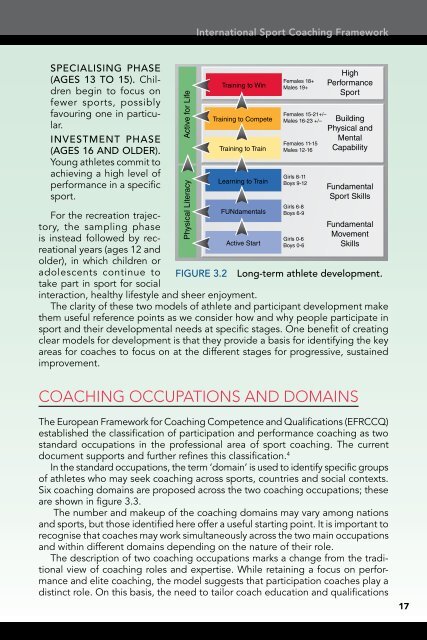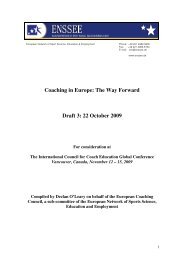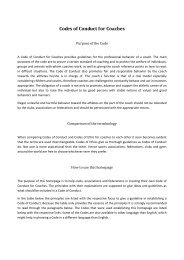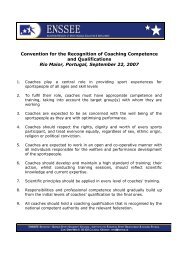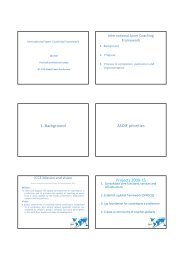International Sport Coaching Framework â version 1.1
International Sport Coaching Framework â version 1.1
International Sport Coaching Framework â version 1.1
Create successful ePaper yourself
Turn your PDF publications into a flip-book with our unique Google optimized e-Paper software.
<strong>International</strong> <strong>Sport</strong> <strong>Coaching</strong> <strong>Framework</strong><br />
SPECIALISING PHASE<br />
(AGES 13 TO 15). Children<br />
begin to focus on<br />
fewer sports, possibly<br />
favouring one in particular.<br />
INVESTMENT PHASE<br />
(AGES 16 AND OLDER).<br />
Young athletes commit to<br />
achieving a high level of<br />
performance in a specific<br />
sport.<br />
For the recreation trajectory,<br />
the sampling phase<br />
is instead followed by recreational<br />
years (ages 12 and<br />
Active Start<br />
older), in which children or<br />
adolescents continue to<br />
take part in sport for social<br />
interaction, healthy lifestyle and sheer enjoyment.<br />
Active for Life<br />
Physical Literacy<br />
Training to Win<br />
Training to Compete<br />
Training to Train<br />
Learning to Train<br />
FUNdamentals<br />
Females 18+<br />
Males 19+<br />
Females 15-21+/–<br />
Males 16-23 +/–<br />
Females 11-15<br />
Males 12-16<br />
Girls 8-11<br />
Boys 9-12<br />
Girls 6-8<br />
Boys 6-9<br />
Girls 0-6<br />
Boys 0-6<br />
High<br />
Performance<br />
<strong>Sport</strong><br />
Building<br />
Physical and<br />
Mental<br />
Capability<br />
Fundamental<br />
<strong>Sport</strong> Skills<br />
Fundamental<br />
Movement<br />
Skills<br />
FIGURE 3.2 Long-term athlete development.<br />
The clarity of these two models of athlete and participant development make<br />
them useful reference points as we consider how and why people participate in<br />
sport and their developmental needs at specific stages. One benefit of creating<br />
clear models for development is that they provide a basis for identifying the key<br />
areas for coaches to focus on at the different stages for progressive, sustained<br />
improvement.<br />
COACHING OCCUPATIONS AND DOMAINS<br />
The European <strong>Framework</strong> for <strong>Coaching</strong> Competence and Qualifications (EFRCCQ)<br />
established the classification of participation and performance coaching as two<br />
standard occupations in the professional area of sport coaching. The current<br />
document supports and further refines this classification. 4<br />
In the standard occupations, the term ‘domain’ is used to identify specific groups<br />
of athletes who may seek coaching across sports, countries and social contexts.<br />
Six coaching domains are proposed across the two coaching occupations; these<br />
are shown in figure 3.3.<br />
The number and makeup of the coaching domains may vary among nations<br />
and sports, but those identified here offer a useful starting point. It is important to<br />
recognise that coaches may work simultaneously across the two main occupations<br />
and within different domains depending on the nature of their role.<br />
The description of two coaching occupations marks a change from the traditional<br />
view of coaching roles and expertise. While retaining a focus on performance<br />
and elite coaching, the model suggests that participation coaches play a<br />
distinct role. On this basis, the need to tailor coach education and qualifications<br />
17


